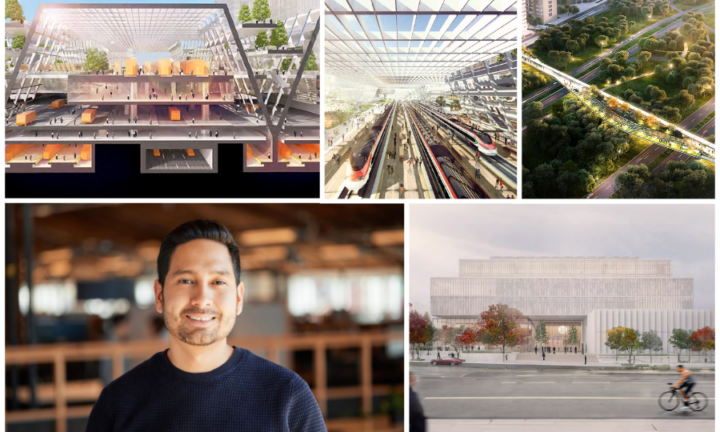Mithun is back again this year at the Festival with Sound & Place – an interactive installation that incorporates elements of sound, light and shadow to invite users of all ages and abilities. Visitors will experience a combination of analog and digitally amplified sound elements which, combined with selective visual screening and framing of views, create a space for reflection on the past, present and future of the site.
Sound & Place will be present at the SDF Block Party in Lake Union Park this August 17-18!
Hear about what inspires the team’s work in design.
My name is Alex Ayala, and I am an architect at Mithun, based in Seattle. I spent the bulk of my career in Washington DC, engaging in a wide range of cultural, civic, and urban planning projects before relocating to Seattle. Originally from Honduras, I moved to the States at a very young age. Yet, the further I’ve moved, the deeper my appreciation has grown for my diverse Latin heritage—melding Spanish, Native Mesoamerican, and Afro-Caribbean influences. I grew up in Virginia and studied Urban Planning and Architecture at the University of Virginia (UVA), where I discovered my passion for these fields.
Professionally, I am most enthusiastic about projects that sit at the intersection of architecture, urban design, and the natural landscape. I have been fortunate to contribute to projects that embody these disciplines and strongly believe in the power of design to shape communities. I am super inspired by Seattle. With its unique geographic location, it offers an ideal environment to test new ideas, some of which might be challenging to execute elsewhere. I am excited about continuing to grow as a designer and contribute to this vibrant city, surrounded by incredible talent.
Q&A
How do you use WHAT IF? thinking in your work?
“What If?” might initially seem too open-ended, similar to the stress designers often experience in front of a blank sheet of paper. However, it also serves as a catalyst for out-of-the-box thinking. This approach was particularly exciting for our SDF installation team, as it opened a wealth of possibilities for creativity and unconventional thinking. At Mithun, “What If?” is fundamental to our methodology because our projects impact not just our clients but also the everyday people who engage with our spaces.
We frequently challenge ourselves at Mithun with the question, “What if we’re not viewing this through the correct lens?” This consideration reflects on the diverse backgrounds, age groups, mobility needs, and life experiences of those interacting with our projects. We incorporate diverse perspectives in the dialogue because it enriches the process and end-product. Ultimately, our primary task is to bring viable solutions to life. Design involves compromise, and while not every need can be fully addressed, there is profound fulfillment in creating solutions that are shaped by multiple perspectives and collaborative “What Ifs.”
My favorite thing about my city is…
One of the things I love most about Seattle is its breathtaking natural beauty, especially the water that seems to wrap around all sides of the city. It’s truly everywhere, and there’s a certain magic to living in a place where nature feels so close. After spending most of my adult life on the East Coast, where the landscapes are mostly flat, the dramatic scenery of Seattle is a breath of fresh air.
I was born in a mountainous region of Central America, and one memory that has stuck with me is the way my grandmother could pinpoint her location just by glancing at the mountains, even within the confines of a gridded Spanish colonial city! Seattle reminds me so much of those childhood days.
What design object or story most strongly influenced your interest in design?
While studying architecture and urban planning, the one project that profoundly influenced my interest in design was the Quinta Monroy Housing project by the firm Elemental, led by Alejandro Aravena. This project was a lightbulb moment for me, exemplifying how architecture and urbanism could tackle deep social and economic issues in Latin America.
Quinta Monroy was particularly revolutionary for its “incremental” housing concept, where the initial structure is partially completed, and residents continue building their homes as resources become available. This approach not only makes housing affordable but also empowers the community to personalize their living spaces over time. I think this strategy effectively addressed core issues without being patronizing, by providing people a platform to build their lives upon. Aravena’s work demonstrated the potential of architecture to foster community engagement and facilitate sustainable development.
Aravena’s decision to release these designs as open-source further underlined his commitment to social impact, providing a blueprint for tackling the global housing crisis. This project captured my imagination about how complex challenges can be met through innovative design, collaboration, and a genuine interest in enhancing our communities.
How should community influence design?
Community involvement is crucial in design, and I believe it starts with designers immersing themselves in the communities they are designing for. Observing and participating in daily life provides invaluable insights that can’t be gained from a distance. Everything around us—from our homes to our workplaces—was once a topic of careful thought and debate. Yet, sometimes, we become too comfortable with the status quo and stop listening to what our community truly needs.
It’s also essential to challenge the notion that good design must be expensive or exclusive to the affluent. Quality design should be accessible to more people, breaking away from being perceived as a luxury. However, it should also avoid being stale, repetitive, and boring. Instead, design should be quirky and unique, reflecting the diverse characteristics of its community. After all, if our communities are weird and quirky, shouldn’t our spaces reflect that too?
By embracing community feedback and continuously adapting, we can ensure that our designs not only meet current needs but also enrich the community’s way of life.





